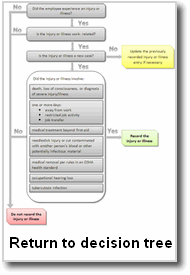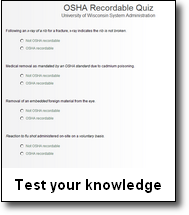Coordinators
Definition of medical treatment
Medical treatment means the management and care of a patient to combat disease or disorder. Medical treatment includes:
- All treatment not otherwise excluded (below).
- Using prescription medications, or use of a non-prescription drug at prescription strength.
- Using wound closing devices such as surgical glue, sutures, and staples.
- Using any devices with rigid stays or other systems designed to immobilize parts of the body.
- Administration of oxygen to treat injury or illness.
Exclusions from definition of medical treatment
For OSHA recording purposes, medical treatment excludes the following items:
- Observation or counseling. Visits to a physician or other licensed health care professional solely for observation or counseling;
- Diagnostic procedures. The conduct of diagnostic procedures, such as x-rays and blood tests, including the administration of prescription medications used solely for diagnostic purposes (e.g., eye drops to dilate pupils); or
- First aid. First aid as defined below.
Definition of first aid — excluded from medical treatment
For OSHA recording purposes, “first aid” includes the following items. This is a complete list of all treatments considered to be first aid by OSHA.
- Using a non-prescription medication at nonprescription strength (NOTE: for medications available in both prescription and non-prescription form, a recommendation by a physician or other licensed health care professional to use a non-prescription medication at prescription strength is considered medical treatment for recordkeeping purposes);
- Administering tetanus immunizations (NOTE: other immunizations, such as Hepatitis B vaccine or rabies vaccine, are considered medical treatment);
- Cleaning, flushing or soaking wounds on the surface of the skin;
- Using wound coverings such as bandages, Band-Aids™, gauze pads, etc.; or using butterfly bandages or Steri-Strips™ (NOTE: other wound closing devices such as sutures, staples, etc., are considered medical treatment);
- Using hot or cold therapy;
- Using any non-rigid means of support, such as elastic bandages, wraps, non-rigid back belts, etc. (NOTE: devices with rigid stays or other systems designed to immobilize parts of the body are considered medical treatment for recordkeeping purposes);
- Using temporary immobilization devices while transporting an accident victim (e.g., splints, slings, neck collars, back boards, etc.).
- Drilling of a fingernail or toenail to relieve pressure, or draining fluid from a blister;
- Using eye patches;
- Removing foreign bodies from the eye using only irrigation or a cotton swab;
- Removing splinters or foreign material from areas other than the eye by irrigation, tweezers, cotton swabs or other simple means;
- Using finger guards;
- Using massages (NOTE: physical therapy or chiropractic treatment are considered medical treatment for recordkeeping purposes); or
- Drinking fluids for relief of heat stress.
Notification requirements
Your campus has an obligation to notify state regulators about the following event within eight (8) hours of their occurrence:
- the death of any UW System employee from a work-related incident or
- the in-patient hospitalization of three or more UW System employees as a result of a work-related incident.
If either of these events, campus must contact the Department of Safety and Professional Services at 608-266-2112 during normal business hours. During non-business hours, contact the State Division of Emergency Management at 800-943-0003. Worker’s compensation coordinators should verify who is responsible for their campus notification in these situations.
Other references
OSHA Recordkeeping Handbook: For more information on recording criteria for cases involving medical treatment and and the criteria for first aid.


